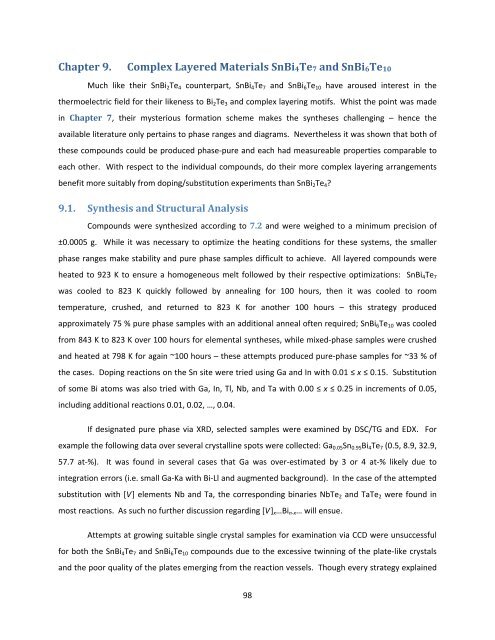Exploration and Optimization of Tellurium‐Based Thermoelectrics
Exploration and Optimization of Tellurium‐Based Thermoelectrics
Exploration and Optimization of Tellurium‐Based Thermoelectrics
Create successful ePaper yourself
Turn your PDF publications into a flip-book with our unique Google optimized e-Paper software.
Chapter 9. Complex Layered Materials SnBi4Te7 <strong>and</strong> SnBi6Te10<br />
Much like their SnBi2Te4 counterpart, SnBi4Te7 <strong>and</strong> SnBi6Te10 have aroused interest in the<br />
thermoelectric field for their likeness to Bi2Te3 <strong>and</strong> complex layering motifs. Whist the point was made<br />
in Chapter 7, their mysterious formation scheme makes the syntheses challenging – hence the<br />
available literature only pertains to phase ranges <strong>and</strong> diagrams. Nevertheless it was shown that both <strong>of</strong><br />
these compounds could be produced phase‐pure <strong>and</strong> each had measureable properties comparable to<br />
each other. With respect to the individual compounds, do their more complex layering arrangements<br />
benefit more suitably from doping/substitution experiments than SnBi2Te4?<br />
9.1. Synthesis <strong>and</strong> Structural Analysis<br />
Compounds were synthesized according to 7.2 <strong>and</strong> were weighed to a minimum precision <strong>of</strong><br />
±0.0005 g. While it was necessary to optimize the heating conditions for these systems, the smaller<br />
phase ranges make stability <strong>and</strong> pure phase samples difficult to achieve. All layered compounds were<br />
heated to 923 K to ensure a homogeneous melt followed by their respective optimizations: SnBi4Te7<br />
was cooled to 823 K quickly followed by annealing for 100 hours, then it was cooled to room<br />
temperature, crushed, <strong>and</strong> returned to 823 K for another 100 hours – this strategy produced<br />
approximately 75 % pure phase samples with an additional anneal <strong>of</strong>ten required; SnBi6Te10 was cooled<br />
from 843 K to 823 K over 100 hours for elemental syntheses, while mixed‐phase samples were crushed<br />
<strong>and</strong> heated at 798 K for again ~100 hours – these attempts produced pure‐phase samples for ~33 % <strong>of</strong><br />
the cases. Doping reactions on the Sn site were tried using Ga <strong>and</strong> In with 0.01 ≤ x ≤ 0.15. Substitution<br />
<strong>of</strong> some Bi atoms was also tried with Ga, In, Tl, Nb, <strong>and</strong> Ta with 0.00 ≤ x ≤ 0.25 in increments <strong>of</strong> 0.05,<br />
including additional reactions 0.01, 0.02, …, 0.04.<br />
If designated pure phase via XRD, selected samples were examined by DSC/TG <strong>and</strong> EDX. For<br />
example the following data over several crystalline spots were collected: Ga0.05Sn0.95Bi4Te7 (0.5, 8.9, 32.9,<br />
57.7 at‐%). It was found in several cases that Ga was over‐estimated by 3 or 4 at‐% likely due to<br />
integration errors (i.e. small Ga‐Ka with Bi‐Ll <strong>and</strong> augmented background). In the case <strong>of</strong> the attempted<br />
substitution with [V] elements Nb <strong>and</strong> Ta, the corresponding binaries NbTe2 <strong>and</strong> TaTe2 were found in<br />
most reactions. As such no further discussion regarding [V]x…Bin‐x… will ensue.<br />
Attempts at growing suitable single crystal samples for examination via CCD were unsuccessful<br />
for both the SnBi4Te7 <strong>and</strong> SnBi6Te10 compounds due to the excessive twinning <strong>of</strong> the plate‐like crystals<br />
<strong>and</strong> the poor quality <strong>of</strong> the plates emerging from the reaction vessels. Though every strategy explained<br />
98
















